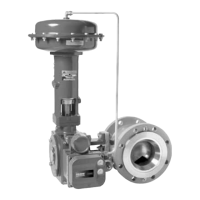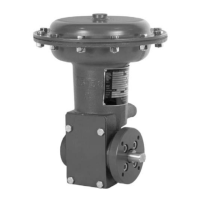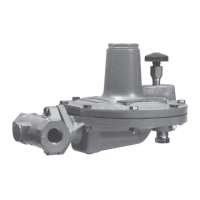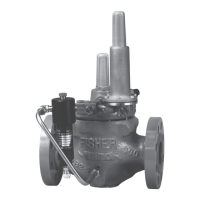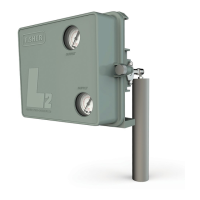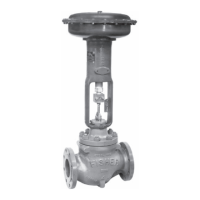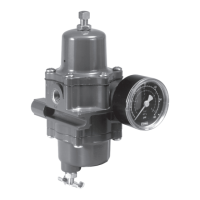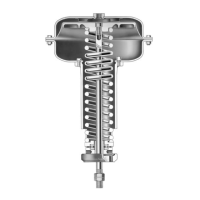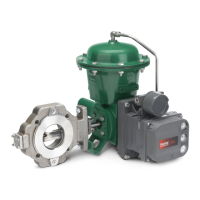Instruction Manual
D100331X012
1066 and 1066SR F & G Actuators
October 2012
6
1. Isolatethecontrolvalvefromthelinepressure,releasepressure from both sides of the valve body, and drain the
process media from both sides of the valve. Also, shut off all pressure lines, and release all pressure to the actuator.
Uselock-outprocedurestobesurethattheabovemeasuresstayineffectwhileyouworkontheequipment.
2. Refer to figure 2 for available mounting positions. The actuator is normally positioned vertically on a valve that is
installed with the shaft horizontal in the pipeline as shown in figure 2.
3. Remove the machine screws (key 24), the travel indicator (key 22), and the spacer (key 26) from the actuator.
CAUTION
When removing the actuator from the valve, do not use a hammer or similar tool to drive the hub a nd bearing assembly off
the valve shaft. This could damage the valve internal parts.
If necessary, use a wheel puller to remove the hub and bearing assembly or actuator from the valve shaft. It is acceptable to
tap the wheel puller screw lightly to loosen the actuator, but hitting the screw w ith excessive force could damage internal
valve parts.
4. Remove the actuator assembly from the valve shaft.
Assembly
1. Position the actuator according to the appropriate mounting position you have selected.
2. If the mounting position and style desired requires moving the mounting yoke (key 25) and travel indicator scale
(key 21) to opposite sides of the actuator, remove the cap screws (key 20) from both sides of the actuator. Then,
removethemountingyokeandtravelindicatorscaleandpositionthemontheappropriatesidesoftheactuator.
3. Secure the mounting yoke and travel indicator scale to the actuator with the cap screws (key 20). Tighten the cap
screws to 25 NSm(18lbfSft) for size 20 and 27 actuators and to 102 NSm(75lbfS ft) for size 75 actuators.
4. Theindexmarkonthevalveshaftmustbealignedwithoneofthefourindexholesontheendoftheactuatorhub
(key 6).
CAUTION
As discussed in the following paragraph, mount the actuator on the valve so that the hub slides onto the shaft without
damaging the hub.
Consult the appropriate valve instruction manual for lever/shaft index mark or hole to position the shaft correctly. Be
sure valve/actuator action is matched. Some valve applications require PDTO (push-down-to-open) fail action, while
others require PDTC (push-down-to-close) fail action. Most valves or other applications require the actuator to limit
travel to prevent damage. Mount the actuator on the valve so that the hub slides onto the shaft without damaging the
hub.
5. Securethemountingyoke(key25)tothevalvebodyasfollows:
D If using the F Mounting Style, secure the mounting yoke to the valve body with the valve body cap screws. Tighten
thecapscrewstothetorquegiveninthevalveinstructionmanual.
D If using the G Mounting Style, secure the mounting yoke to the valve body with the cap screws and washers (keys 36
and 38, not shown). Tighten the cap screws.
6. Install the spacer (key 26).
7. Note the actuator position, the valve disc or ball position, and the direction of rotation. Position the travel indicator
(key 22) accordingly and fasten it with the machine screws (key 24).

